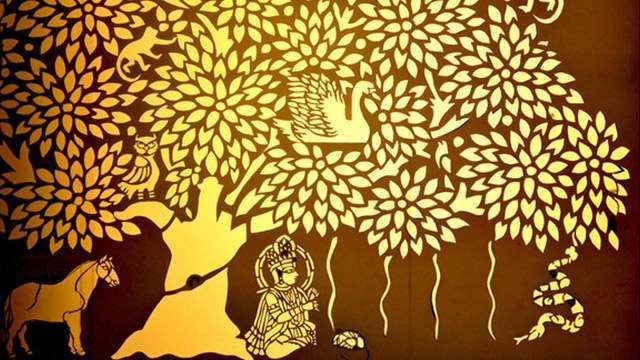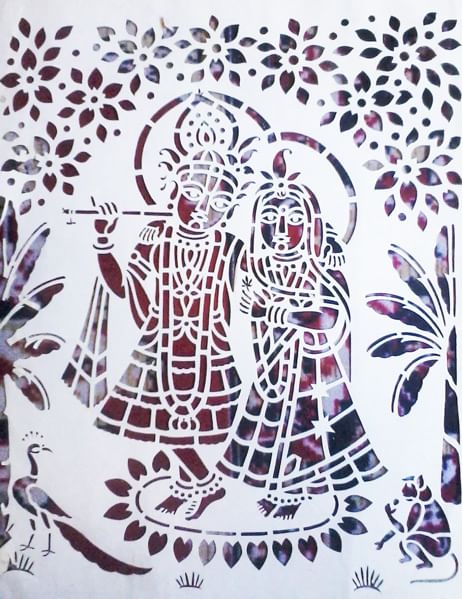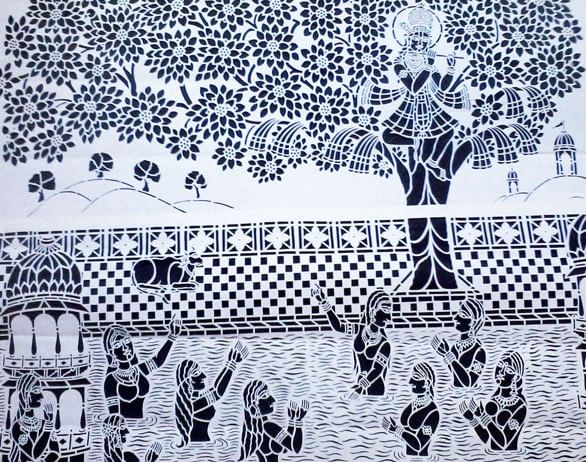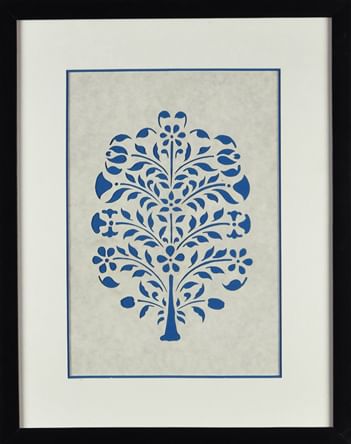Sanjhi Art - The Miracles of Paper and Scissors
In today's Hands of Grace article, we take a look at Saanjhi Paper Art, a traditional form of stenciled paper cutting, that serves as a conduit of expression for artists’ devotion to Krishna.

Sanjhi Art from Mathura, is a truly unique craft form that features exquisite designs and intricate picture motifs, cut into paper. Craftsmen use specially designed scissors to accomplish this process. Let's take a look at the history and current state of this artform.
Craft: Sanjhi Art
Artisan: Vijay and Mohan Kumar Verma
Place: Mathura, Uttar Pradesh
Items: Lamp shades, curtains, wall frames and other household products.

Sanjhi art is the traditional art of stenciling from Mathura, Krishna’s hometown. Known for its inherent spiritual implications that reach beyond immediate aesthetic appeal, it is considered to be one of the finest arts of spiritual expression. The art grew in the 16th and 17th centuries, when the walls and floors of temples were decorated with Sanjhi motifs. The term Sanjhi is derived from the Hindi word sandhya, the period of dusk with which the art form is typically associated. The art depicts Indian mythological stories in numerous forms, with predominant focus on Krishna’s Leela.
Subscribe


Folklore tells us that the origins of this art form lie with Radhe, who made Sanjhi rangolis using natural colors, along with flowers, leaves and colored stones, to woo Krishna. The other gopis soon followed suit, also making intricate designs to impress Krishna. Sanjhi has been popular ever since, and during the Mughal period, contemporary themes were introduced for greater perspective. Today, Sanjhi art is found in many homes and spaces. It has been displayed in Delhi metro stations and was recently used for pictograms during the Commonwealth Games.


To create a Sanjhi design, stencils are made on paper (mostly handmade) using specially designed scissors. These stencils are placed on flat surfaces or water, where the rangoli has to be drawn. Dry colors are then sifted onto the surface. Filling the colors and lifting the stencils are as critical as cutting the design. Peacocks, bullock carts, horses, cows, butterflies and trees are some of the common motifs used. The intricate craftsmanship reflects the artist’s devotion and the intimate love for the Blue God. To produce an elaborate Sanjhi design could take anywhere between an hour and a month.


Artists Vijay and Mohan’s family is one of the few custodians of this ancient art form. Their family has been practicing it for several generations. “A person’s mind and heart has to be totally involved during this art, especially while carving Thakurjee (Krishna) with the right expressions,” said Kumar.
Each Sanjhi art piece is visually impressive, owing to the artist’s perfection of portrayal, through the beauty of the shape, a well-matched combination of colors, and the intricacy of ornamental patterns. With over forty in-house craftsmen, the Kumar family has been travelling extensively across the country to conduct workshops on this paper cutting art.
References: Artist interview, Book – “Music and Fine Arts in the Devotional Traditions of India: Worship Through Beauty” By Saurabh Goswami, Selina Thielemann, Newspaper articles (The Hindu, Indian Express), Sanjhi documentary by Devika Gamkhar.
Editor’s Note: More of India's traditional crafts are featured in our Hands of Grace series. Sanjhi art is featured in Hands of Grace, a biannual handicrafts exposition, organized by Isha Foundation. The exposition showcases thousands of exquisite items including furniture, interior décor, garments, organic bodycare products, stone and metal crafts, accessories and gift items, offering the gamut of India’s arts and crafts tradition. Hands of Grace is an endeavor of Isha Foundation that seeks to rejuvenate India’s traditional arts and crafts industry and establish a lasting legacy for future generations. It is a part of Isha’s larger initiative to revive India’s cultural ethos.




